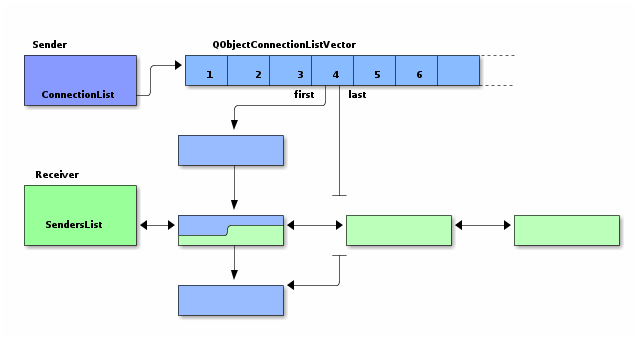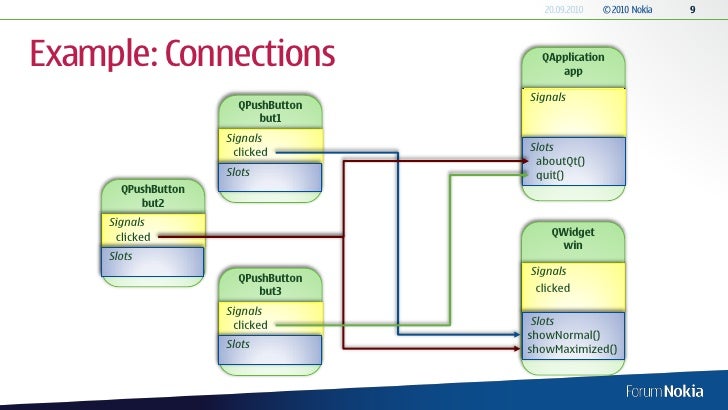Signals And Slots Across Threads Qt
This page describes the use of signals and slots in Qt for Python.The emphasis is on illustrating the use of so-called new-style signals and slots, although the traditional syntax is also given as a reference.

The Qt signals/slots and property system are based on the ability to introspect the objects at runtime. Introspection means being able to list the methods and properties of an object and have all kinds of information about them such as the type of their arguments. Signals And Slots Across Threads Qt Neteller do not qualify for this bonus offer. The bonus offer is Signals And Slots Across Threads Qt available to players from: Andorra, Gibraltar, Malta, Iceland, Liechtenstein, Monaco and Luxembourg. Players must wager the bonus amounts Signals And Slots Across Threads Qt 35 times. 18+, New Players Only.
The main goal of this new-style is to provide a more Pythonic syntax to Python programmers.
- 2New syntax: Signal() and Slot()
Traditional syntax: SIGNAL () and SLOT()
QtCore.SIGNAL() and QtCore.SLOT() macros allow Python to interface with Qt signal and slot delivery mechanisms.This is the old way of using signals and slots.
The example below uses the well known clicked signal from a QPushButton.The connect method has a non python-friendly syntax.It is necessary to inform the object, its signal (via macro) and a slot to be connected to.

New syntax: Signal() and Slot()
The new-style uses a different syntax to create and to connect signals and slots.The previous example could be rewritten as:
Using QtCore.Signal()
Signals can be defined using the QtCore.Signal() class.Python types and C types can be passed as parameters to it.If you need to overload it just pass the types as tuples or lists.
In addition to that, it can receive also a named argument name that defines the signal name.If nothing is passed as name then the new signal will have the same name as the variable that it is being assigned to.
The Examples section below has a collection of examples on the use of QtCore.Signal().
Note: Signals should be defined only within classes inheriting from QObject.This way the signal information is added to the class QMetaObject structure.
Using QtCore.Slot()
Slots are assigned and overloaded using the decorator QtCore.Slot().Again, to define a signature just pass the types like the QtCore.Signal() class.Unlike the Signal() class, to overload a function, you don't pass every variation as tuple or list.Instead, you have to define a new decorator for every different signature.The examples section below will make it clearer.
Another difference is about its keywords.Slot() accepts a name and a result.The result keyword defines the type that will be returned and can be a C or Python type.name behaves the same way as in Signal().If nothing is passed as name then the new slot will have the same name as the function that is being decorated.
Examples
The examples below illustrate how to define and connect signals and slots in PySide2.Both basic connections and more complex examples are given.
- Hello World example: the basic example, showing how to connect a signal to a slot without any parameters.
- Next, some arguments are added. This is a modified Hello World version. Some arguments are added to the slot and a new signal is created.
- Add some overloads. A small modification of the previous example, now with overloaded decorators.
- An example with slot overloads and more complicated signal connections and emissions (note that when passing arguments to a signal you use '[]'):
- An example of an object method emitting a signal:
- An example of a signal emitted from another QThread:
- Signals are runtime objects owned by instances, they are not class attributes:
Qt Signal Slot Example
Qt - Passing custom objects among threads
- Details
- Category: Programming
- Written by Nandan Banerjee
- Hits: 13035
Signals And Slots Across Threads Qtc
Communication between threads in a qt program is essentially done by using signals/slots. This is by far one of the most easiest and stable mode of communication amongst threads of a program.
For example, let us suppose that one thread needs to send an integer value to another thread. All the programmer needs to do is simply create a dispatch signal with two arguments, the thread id and the integer value. Thus, it can be achieved by this simple line –
Similarly, a receive slot with the same arguments needs to be created to receive the signal.
Now, this will work very nicely when one is dealing with the predefined primitive or the qt data types. This is because they are already registered and hence it is not a problem for qt to recognise those data types.

The problem arises when one wants to pass a custom data type (any class or structure that has a public default constructor, a public copy constructor, and a public destructor can be registered). Then, the user defined class or a class defined in a library not part of qt can be passed using signals/slots after registering.
The qRegisterMetaType() function is used to make the type available to non-template based functions, like the queued signal and slot connections.
This is done in the following way –
Qt Signal Slot Not Working
where name can be any custom data type.
For example, let us take a program which will capture the image from the webcam and display it in a QLabel on the GUI. To achieve this, two approaches can be taken. Run the camera grabbing function in the main UI thread or in a different thread and reducing the work of the UI thread significantly. If it is run in the main UI thread, then the chances of the UI thread not responding is very high. Therefore, it is always desirable make a separate thread and use it instead to run the camera grabbing function.
In this tutorial, we will use the openCV library to grab an image from the webcam and use the signal/slot mechanism to send the image (IplImage type) to the UI thread.
After creating a new qtGUI project, a new class is created (say “webcamThread”) with QThread as its parent class. A run() function is defined and a new signal with the image as the argument is defined.
In the MainWindow file, a slot is defined to handle the signal from the webcamThread. This image is then converted to the QImage format and then displayed in the QLabel. So, a smooth and pleasant webcam feed can be achieved using this.
Qt code for the webcam feed -
The openCV library needs to be present in the system and the paths should be appropriately set.
// webcamthread.h

// webcamthread.cpp
Now the code for the MainWindow. The signals are connected with the slots and the event handlers are defined.
// mainwindow.h
// mainwindow.cpp
In the UI editor, two buttons (Start and Stop) and a label of size 320 by 240 need to be created. Then, just compile and run. So, it can be seen that objects of the class “IplImage” from the openCV library can be easily passed between the threads just by registering the class.